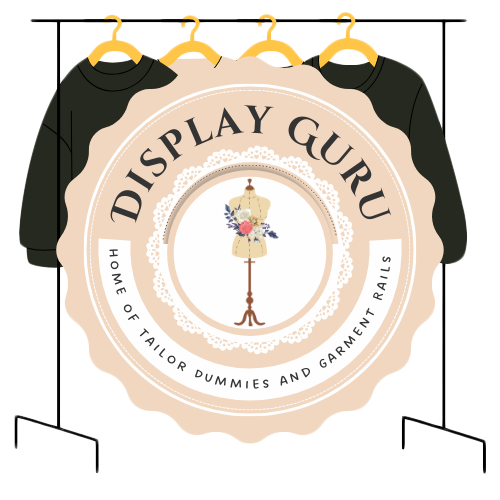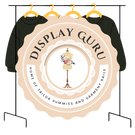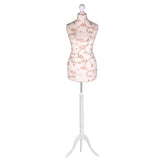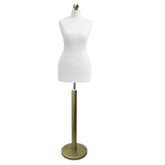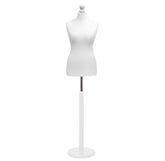How to Start a Fashion Business: Your Step-by-Step Guide
So, you have a brilliant idea for a fashion line. That's fantastic, but a great design is just the beginning. To turn that creative spark into a real, thriving business, you need a solid blueprint. This is the part where you map out your brand identity, your place in the market, and your financial strategy. Honestly, this planning phase is the most critical part of the entire journey.
Building Your Fashion Brand Foundation
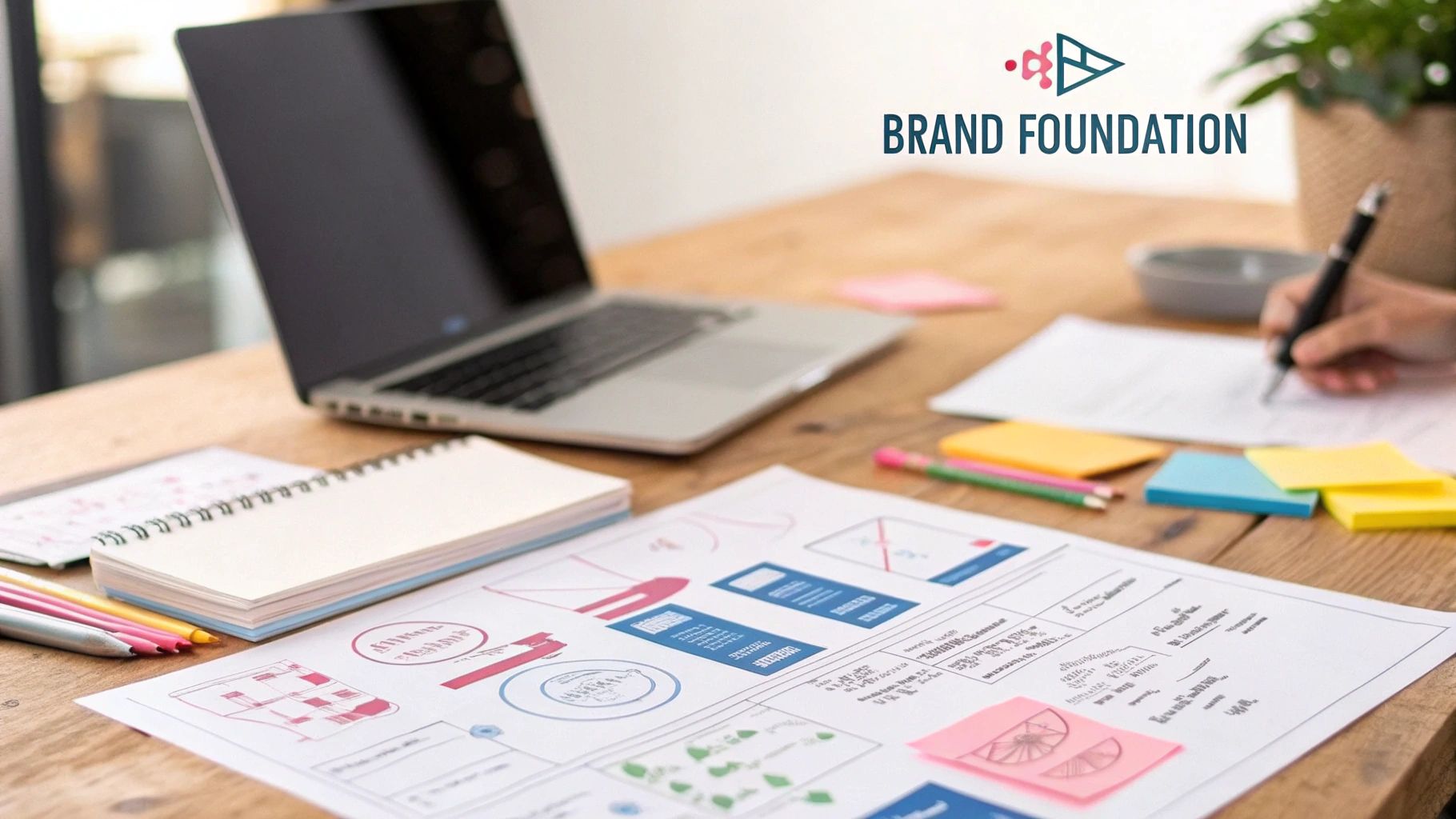
Before a single stitch is sewn, the groundwork you lay will make or break your brand. I’ve seen too many aspiring designers jump straight into creating products, only to face costly mistakes down the line. The brands that truly succeed start with a crystal-clear vision and a deep understanding of the market they’re stepping into. It’s about treating your idea like a serious business from day one.
The UK's fashion industry is a powerhouse, contributing around £66.9 billion to the economy. For newcomers, this buzzing environment is full of opportunity, especially online. By 2025, e-commerce is expected to account for a staggering 78% of all fashion sales. That number alone should tell you that a strong digital game plan isn't optional; it's essential.
Defining Your Niche And Brand Vision
Your brand's vision is its soul. It's the story you want to tell, the feeling you want your customers to have when they wear your clothes. Are you building a luxury brand rooted in sustainable, artisanal materials? Or maybe a raw, edgy streetwear label inspired by urban culture? This vision becomes your North Star, guiding every single decision you make.
To really make an impact, you have to find your niche. "Women's clothing" is far too broad. You need to drill down. Think about specific, often overlooked groups:
- Adaptive clothing for individuals with disabilities.
- Petite-fit professional wear, a market that's consistently underserved.
- Eco-friendly formalwear crafted from recycled textiles.
Focusing on a niche lets you build a genuine connection with a dedicated audience instead of getting drowned out by the big-name brands.
A brand that tries to be for everyone ultimately ends up being for no one. Your unique selling proposition (USP) isn't just a marketing term; it's the core reason a customer will choose you over a competitor.
Conducting Meaningful Market Research
Once you have a vision, you need to see if it holds water. Market research isn't about looking for information that confirms what you already think. It's about uncovering real market needs and spotting potential roadblocks before you hit them.
Start by creating a vivid profile of your ideal customer. Don't just stick to age and location; dig into their lifestyle, what they value, their shopping habits, and the problems they're trying to solve. Then, turn your attention to the competition. Pick out 3-5 brands already playing in your chosen niche and study them. What are they selling? How do they price it? Where do they market? What are their customers saying in reviews? The goal isn't to copy them, but to find the gaps they've left open for you to fill.
As you start to firm up these ideas, a complete step-by-step guide on how to create brand guidelines can be an invaluable resource to help solidify your brand’s identity.
Creating Your Business Plan
A formal business plan is your roadmap. It forces you to think through every single aspect of your venture, from the creative to the commercial. If you ever plan on seeking funding from investors or a bank, it's non-negotiable.
This document is where your designs meet the reality of sales and operations. It’s also where you should start thinking about the practicalities of product presentation. Effective fashion merchandising is what translates your brand story into sales, whether that's on a website or in a physical shop. Planning for this now ensures your product strategy and commercial goals are aligned from the very start. To get a better handle on this, have a look at our guide that explains what fashion merchandising is and why it's so important.
Here's a breakdown of the core components every fashion business plan should cover to ensure you're building on a solid foundation.
Core Components of Your Fashion Business Plan
| Component | Key Focus Areas | Why It Matters |
|---|---|---|
| Executive Summary | A concise overview of your entire business concept, mission, and vision. | This is your "elevator pitch" to capture the attention of investors, partners, and even yourself. |
| Company Description | Your brand's story, legal structure, niche, and what makes you unique (your USP). | It clearly defines who you are and what you stand for, setting the tone for your entire brand. |
| Market Analysis | Detailed research on your target audience, industry trends, and a thorough competitor analysis. | Validates your idea by proving there's a real, addressable market and shows you understand the competitive landscape. |
| Products & Services | A full breakdown of your product line, sourcing strategy, and production process. | Articulates the tangible value you're offering to customers and outlines the practicalities of bringing it to life. |
| Marketing & Sales Plan | Your strategies for branding, pricing, promotion, and distribution (both online and offline). | This is your plan for how you’ll actually reach customers and generate revenue. |
| Financial Projections | Realistic forecasts including start-up costs, projected profit and loss, cash flow statements, and break-even analysis. | Demonstrates the financial viability of your business and is crucial for securing any external funding. |
A well-thought-out plan doesn't just look good on paper; it acts as a living document that guides your decisions as you grow. Getting these details right from the outset prepares you for all the exciting (and challenging) steps ahead.
Designing a Memorable Brand and First Collection
With your business plan locked down, it's time to swap spreadsheets for sketchbooks. This is where the magic happens—when your abstract ideas start to take shape as a real brand and a collection that people can actually wear and connect with. You're not just making clothes; you're building a world around your products that needs to speak directly to your ideal customer.
Your brand identity is the soul of your business. It's the sum of your name, your logo, your colour palette, and the feeling you want to create. Nailing this at the start is absolutely crucial, as it will guide every decision you make, from product design to your marketing campaigns.
Before anything else, you need to master how to choose a brand name that feels right and clicks with your audience. Just think about the brands you love. Their names often tell a story or hint at a core value in just a word or two. This is the bedrock of everything you're about to build.
Creating the Mood and Vision
The first real step in designing a collection is always the mood board. It’s far more than a pretty collage; it's a strategic tool that maps out the story your collection will tell. A good mood board sets the tone for every single garment, ensuring the entire collection feels cohesive and intentional.
Your mood board should be a focused mix of:
- Inspirational Imagery: Photos that capture the specific feeling, time period, or place that sparked your idea.
- Colour Swatches: A tight palette of core and accent colours that will define the collection's look.
- Fabric Textures: Little swatches or high-quality images of fabrics that convey the touch, feel, and quality you're aiming for.
- Key Silhouettes: A few sketches or images of the core shapes that will anchor your designs.
This visual blueprint is your North Star. It'll keep you on track and stop you from designing a random jumble of pieces, helping you instead to build a curated collection where every item has its place.
From Sketch to Technical Pack
With your vision clear, you can finally start sketching your designs. This is where you translate the feeling of your mood board into tangible garments. As you draw, constantly ask yourself how each piece serves your customer. Does it solve a problem for them? Does it fit seamlessly into their life?
Once your sketches are finalised, you move on to what is arguably the most critical document in the entire process: the technical pack, or "tech pack." A tech pack is the detailed instruction manual you give to a manufacturer. It communicates every single detail of your design. Trust me, a vague or incomplete tech pack is a one-way ticket to costly mistakes and frustrating delays.
The chart below shows how these key documents guide an idea from a spark of inspiration to a product ready for manufacturing.
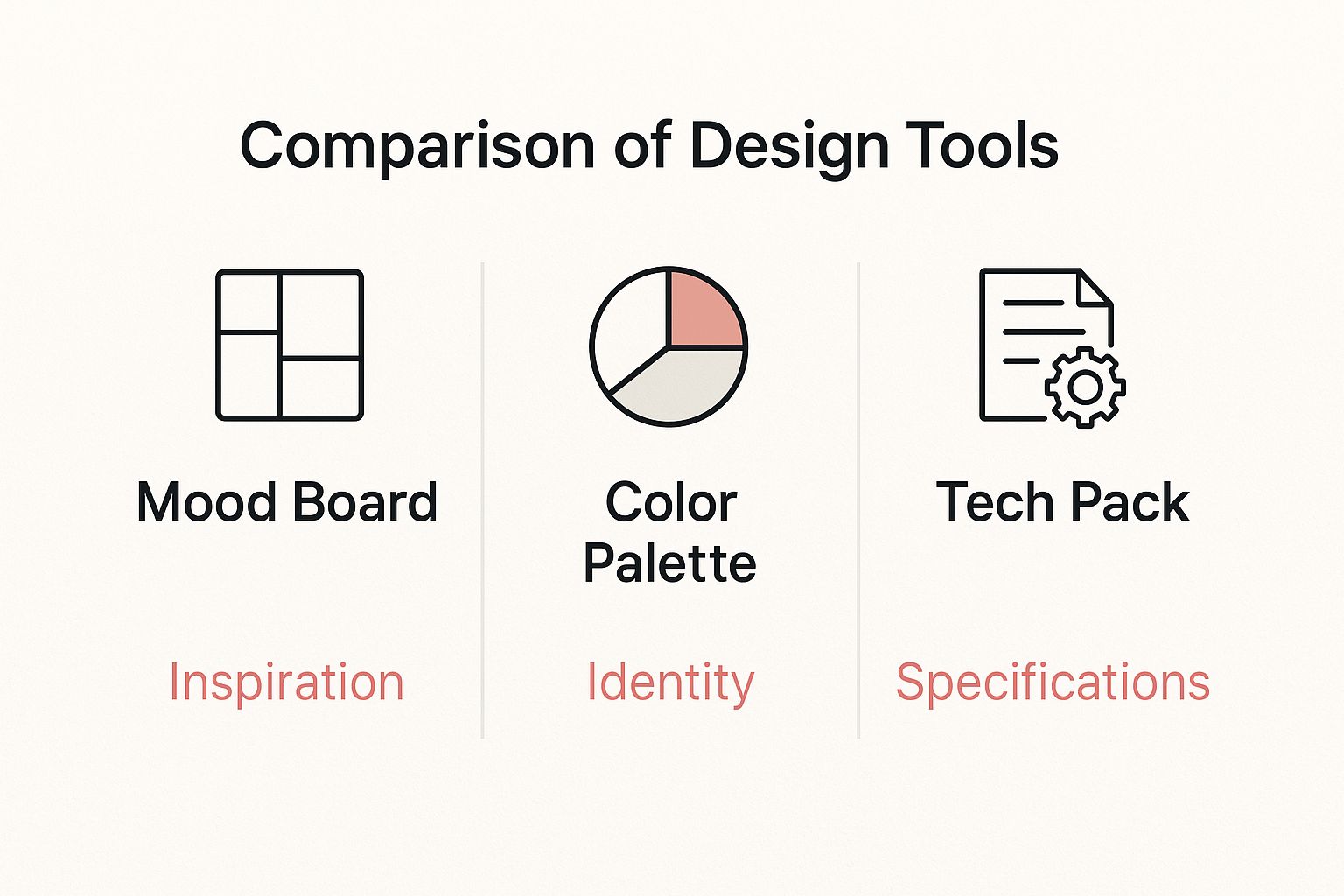
As you can see, the process is a funnel, moving from broad inspiration to the hyper-specific, actionable instructions needed to actually make something.
A solid tech pack leaves no room for interpretation. It must include detailed sketches, precise measurements, fabric choices, trim details, and specific construction notes. If you want to see how the pros present their work, looking through some fashion design portfolio examples is a great way to get inspired.
Your first collection should be a concise, powerful statement. Resist the urge to design everything at once. A focused collection of 8-12 complementary items is far more impactful—and manageable—than a sprawling range that lacks a clear point of view.
Ultimately, designing your brand and first collection is a balancing act between pure creativity and commercial smarts. Every choice you make, from the font on your logo to the stitching on a seam, tells a piece of your brand's story. By building a strong identity and meticulously planning your designs with tools like mood boards and tech packs, you're not just making clothes—you're setting the stage for a brand with real staying power.
Finding the Right Sourcing and Manufacturing Partners
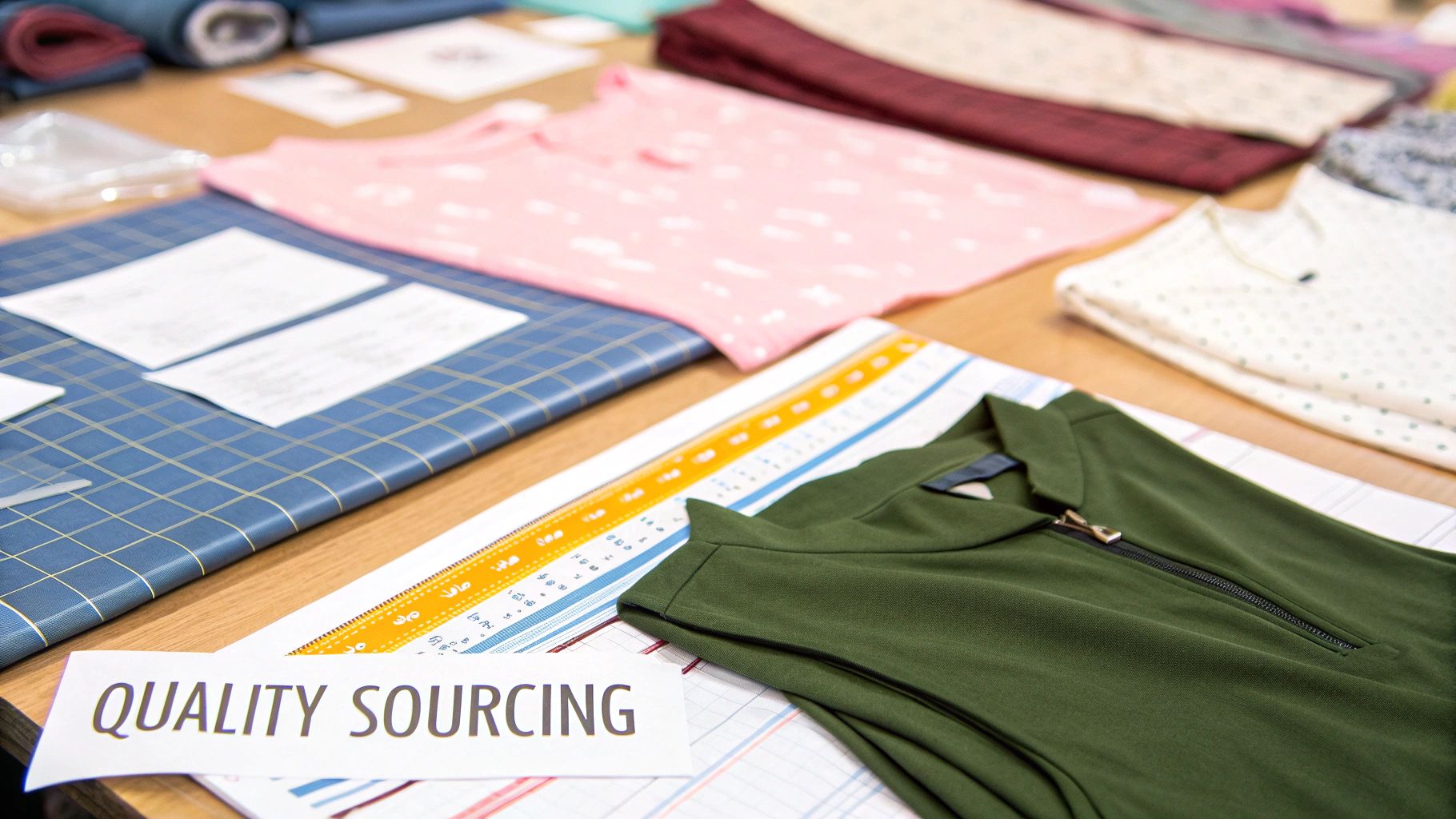
Once your tech packs are finalised, you're standing at a critical crossroads for your fashion business: production. This is where your designs leave the page and become tangible products. The quality of these products will ultimately define your brand’s reputation, and that quality rests entirely on the shoulders of your sourcing and manufacturing partners.
Building a reliable supply chain can feel like a monumental task, but it’s more than achievable with diligent research and crystal-clear communication.
The choices you make now will ripple through your entire business, affecting everything from cost per garment to your brand’s ethical standing. Will you source locally in the UK, championing British craftsmanship, or look overseas for potentially lower production costs? There’s no single right answer here—the best path is the one that aligns with your specific budget, values, and vision.
Exploring Sourcing and Production Models
Before you even think about contacting a factory, you need to decide which production model suits your brand. This choice dictates how you’ll find partners and manage your day-to-day operations. For a new brand, understanding the different paths is vital to finding a good fit for your scale and finances.
Here’s a look at the most common manufacturing models for UK startups and what they mean for you.
Manufacturing Options for UK Startups
| Manufacturing Model | Best For | Pros | Cons |
|---|---|---|---|
| Cut, Make, Trim (CMT) | Founders with supply chain knowledge who want full control over materials and costs. | - Greater control over fabric quality. - Potential for lower per-unit costs. - Flexibility in sourcing unique materials. |
- Requires more hands-on management. - You are responsible for all material logistics. - Can be overwhelming for beginners. |
| Full Production Package (FPP) | New founders or those wanting to focus on design and marketing rather than logistics. | - Simplifies the entire process. - The factory handles all sourcing and logistics. - A single point of contact for production. |
- Higher per-unit cost. - Less control over material choices. - Heavily reliant on the factory's network. |
| In-House Production | Small-batch, artisanal, or bespoke brands that prioritise absolute quality control. | - Unmatched quality oversight. - Maximum agility for design changes. - Strong "handmade" brand story. |
- High initial investment in equipment. - Difficult to scale quickly. - Requires specialised skills. |
Ultimately, choosing a model is a classic trade-off. CMT gives you granular control if you’re keen to manage every fabric and trim, whereas FPP streamlines the entire operation, freeing you up to focus on growing your brand.
How to Find and Vet Potential Partners
Finding the right manufacturer is a bit like matchmaking. You’re looking for a long-term partner whose capabilities, values, and communication style are in perfect harmony with yours. Luckily, there are plenty of avenues to find potential factories, both here in the UK and abroad.
A great place to start is online directories like Sewport, which connect brands with vetted manufacturers. Trade shows are also invaluable. Attending events like The London Textile Fair or Pure London allows you to meet suppliers and factory reps face-to-face. And don't forget the power of your network—asking for recommendations in industry groups on LinkedIn can often lead to the most trusted introductions.
Once you have a shortlist, the real work begins. It’s time to vet them properly.
- Request a Portfolio: Ask to see examples of their previous work, especially garments similar to what you want to create. Look closely at the stitching, the finishing, and the overall construction.
- Discuss Minimum Order Quantities (MOQs): This is a non-negotiable. MOQs are the smallest number of units a factory will produce per style or colour. If their minimums are too high for your initial run, they aren’t the right fit.
- Drill Down on Communication: How do they provide updates? Who is your dedicated point of contact? Solid, consistent communication is the absolute bedrock of a successful manufacturing relationship.
- Enquire About Ethics and Quality Control: Never be shy about asking for certifications or details on their quality assurance processes. A transparent, ethical partner will be more than happy to share this information.
Managing Sampling and Quality Control
The sampling phase is your chance to see if a manufacturer can truly bring your vision to life. Think of it as a dress rehearsal before the main performance. This iterative process of creating prototypes is essential for perfecting the fit, construction, and feel of your garment before you commit to a full production run.
Never, ever skip the sampling stage. It is your single best defence against costly mistakes and a warehouse full of un-sellable stock.
A good partner will guide you through several sample stages, from the first rough prototype to the final pre-production sample. That final sample becomes the "gold standard" against which every single piece in the production run is measured.
Once production kicks off, maintaining that standard is paramount, which leads directly to managing your stock. For more on this, our article covering the best practices for inventory management offers some valuable insights. Getting your supply chain right isn't just a box to tick; it's the very foundation of your brand, setting you up for consistent quality and sustainable growth.
Getting the Legal and Financial Side Sorted
This is the part where your creative vision gets real. Setting up the formal structure for your brand isn't just paperwork; it’s about building a foundation that protects you, lets you operate legally, and actually make money. It might not be as exciting as finalising your first designs, but getting the legal and financial backend right is non-negotiable if you’re serious about launching a fashion business in the UK.
Think of it this way: a brilliant collection without a proper business setup is really just a hobby. A well-organised business, on the other hand, is a brand with true potential. This involves picking the right legal framework, getting to grips with your tax duties, and putting smart financial systems in place from day one.
Choosing Your UK Business Structure
You’ve got a few main options for structuring your business in the UK, and your choice will directly affect your personal liability, how you’re taxed, and the amount of admin you'll have to deal with. There’s no single right answer here—it all comes down to your personal situation and where you want to take the brand.
- Sole Trader: This is the simplest and fastest way to get up and running. You and the business are considered one and the same in the eyes of the law. That’s great because you keep all the profits after tax, but it also means you're personally on the hook for any business debts. It’s a solid choice if you're just starting out and want to test the waters with minimal fuss.
- Limited Company (Ltd): Forming a limited company creates a completely separate legal entity. The big win here is "limited liability," which means your personal assets (like your house or car) are protected if the business runs into debt. It also tends to look more professional to suppliers and investors, but it does come with more formal responsibilities, like filing annual accounts with Companies House.
- Partnership: Going into business with someone else? A partnership is a straightforward option. It works much like being a sole trader, but the profits and liability are shared between the partners. If you go this route, it's absolutely crucial to have a solid partnership agreement drawn up to outline everyone's responsibilities and how profits will be split.
For most new fashion entrepreneurs, it usually boils down to a choice between the simplicity of a sole trader and the protection of a limited company.
Nailing Your Finances and Pricing
As soon as your business is registered, your very next move should be to open a dedicated business bank account. Trust me on this—mixing your personal and business finances is a recipe for an accounting nightmare. It makes it nearly impossible to see if you're actually profitable and will cause massive headaches down the line. Keep them separate from the get-go.
With your bank account sorted, it’s time to get a firm grip on your numbers. This is more than just fiddling with spreadsheets; it's about truly understanding the financial pulse of your brand.
- Build a Start-Up Budget: List every single cost you can think of. I mean everything—from your design software and initial sample runs to website hosting and your first marketing push. Be brutally honest with yourself and then add a 15-20% contingency fund. Unexpected costs always pop up.
- Develop a Smart Pricing Strategy: Your prices need to cover far more than just what it costs to make the clothes. A common starting point is the keystone pricing model, where you double your production cost to get the wholesale price, then double the wholesale price to get the retail price. But you also have to consider your brand's positioning. Are you a luxury brand or an accessible one? What are your competitors charging? You need to factor all of this into your final price.
A classic rookie mistake is underpricing just to get those first few sales. All this does is devalue your brand and make it incredibly difficult to ever become profitable. Price with confidence, based on your real costs, brand value, and your position in the market.
Understanding Tax and Protecting Your Brand
Your legal duties in the UK don't stop at registration. You also need to stay on top of your taxes and, crucially, protect your creative work. Don't put this off.
Tax and VAT Obligations
As a business owner, you’re responsible for paying tax on your profits. This is done through Self Assessment if you're a sole trader or Corporation Tax for a limited company. You also need to be aware of Value Added Tax (VAT). You must register for VAT once your taxable turnover hits the government threshold, which is currently £90,000 over a 12-month period. Even if you’re below that, you can choose to register voluntarily. This can sometimes be a smart move, especially if you have high start-up costs, as you can claim back the VAT you spend.
Protecting Your Intellectual Property
Your brand name and logo are your most valuable assets—treat them that way. Before you fall in love with a name, do a thorough search on the UK's Intellectual Property Office (IPO) website to make sure it isn’t already taken.
Registering your brand name as a trademark gives you the exclusive legal right to use it. This stops anyone else from trading under a similar name, protecting your brand’s identity as you grow. Getting these foundational pieces locked in early gives you the peace of mind and security you need to focus on what you do best: building an incredible fashion brand.
Building Your E-commerce Store and Marketing Plan
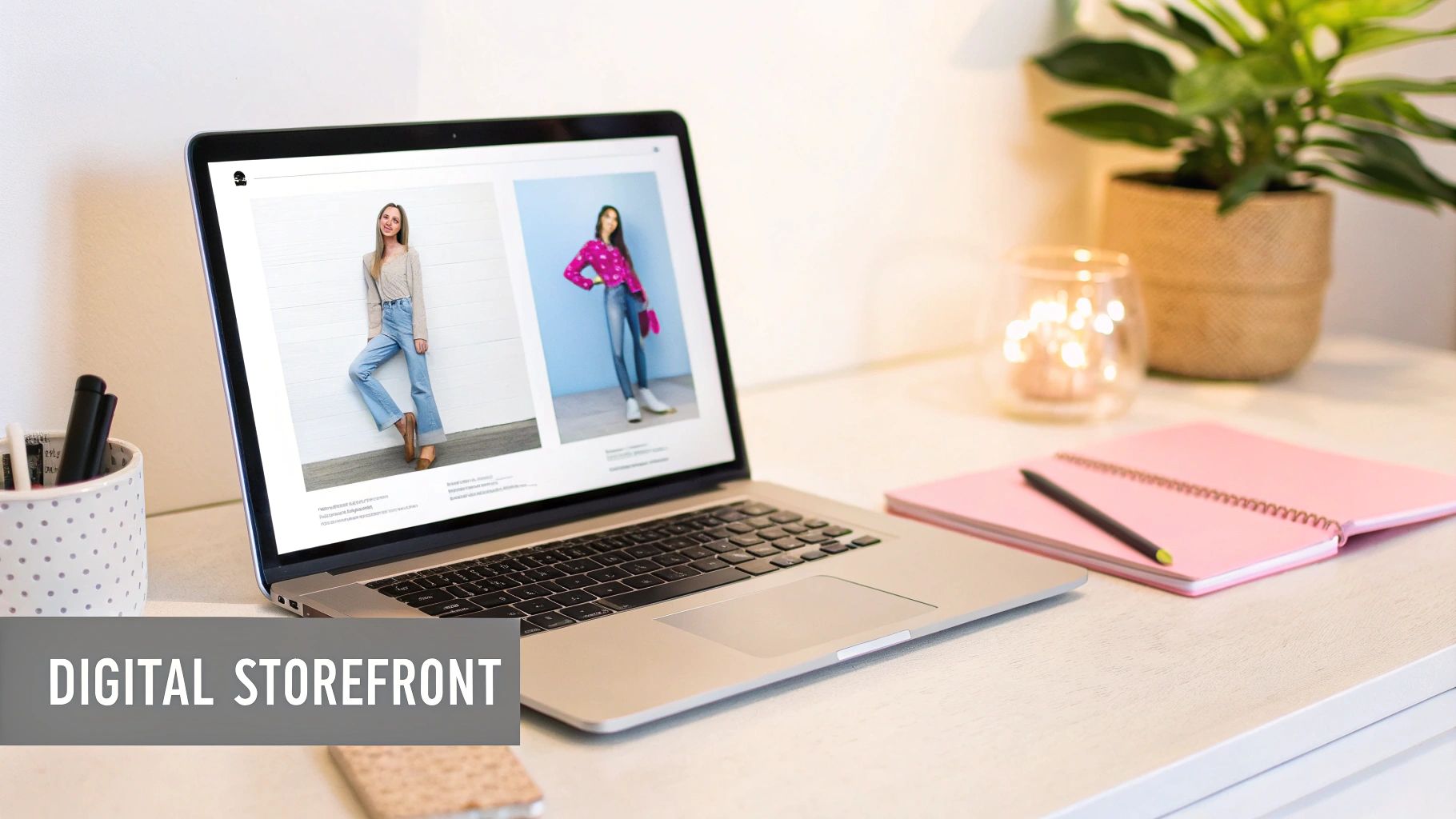
With the legal and financial foundations in place, it’s time to build your digital home. For a new fashion brand, a powerful online presence isn't just part of the business—it is the business. This is where your brand story, your products, and your customer experience all have to come together seamlessly.
Getting your digital storefront right is about so much more than pretty pictures. You need to create a smooth, intuitive journey that can turn a casual browser into a loyal customer. It’s a process that involves picking the right platform, merchandising your products beautifully, and then crafting a marketing plan to bring the right people through your virtual doors.
Choosing Your E-commerce Platform
This is easily one of the most critical technical decisions you'll make. The platform you choose will impact everything from your day-to-day operations to how easily you can scale down the line. For most fashion start-ups, the choice usually boils down to a few key players.
- Shopify: I often see this as the top choice for new fashion brands, mainly due to its scalability and massive app ecosystem. It’s built for one thing—commerce—and it handles everything from inventory to marketing integrations really well.
- Squarespace: This is a fantastic option if visual storytelling is your number one priority. It's known for its beautiful, design-led templates and is incredibly user-friendly, though its pure e-commerce features aren't quite as deep as Shopify's.
- WooCommerce: If you’re already comfortable with WordPress, this is a flexible and powerful route. It gives you endless customisation options but be warned: it comes with a steeper learning curve and requires more hands-on management.
Your final decision should be a balance between your own technical comfort, your budget, and your long-term ambitions. Don't just follow the crowd; pick the platform that genuinely serves your specific brand vision.
Crafting a Compelling Online Store
Think of your website as your 24/7 flagship store. Every single element needs to be meticulously planned to guide customers from that first click all the way to checkout. This means investing real time and effort into an experience that is both beautiful and functional.
Product Presentation and Descriptions
Let’s be clear: high-quality product photography is non-negotiable. Customers can't touch or feel your garments, so your images have to do all the heavy lifting. I always recommend investing in a professional photographer, but if the budget isn't there yet, at least learn the basics of good lighting and styling to create crisp, consistent shots.
Your product descriptions are your digital sales assistants. Don't just list features; sell the feeling. Instead of just saying "100% silk dress," try something like, "Feel the effortless drape of pure silk in a dress designed for sunset dinners and warm summer evenings." You’re telling a story that helps the customer picture themselves in your designs.
A great e-commerce site blends art with science. It uses stunning visuals to capture emotion and intuitive design to make purchasing simple. Your goal is a frictionless experience that feels premium at every click.
The principles of creating an engaging online shop actually borrow a lot from physical retail. For some timeless advice on product presentation, it’s worth exploring established visual merchandising guidelines.
Developing Your Multi-Channel Marketing Plan
Building a gorgeous website is only half the battle. Now you have to get people to it. A smart marketing plan uses several channels at once to build brand awareness and, just as importantly, a community.
You need to focus your energy where your target audience actually spends their time. For most fashion brands today, that means a heavy emphasis on visual social media like Instagram and TikTok. Use these platforms to share behind-the-scenes content, styling guides, and photos from your customers to build an authentic connection.
And please, don’t overlook the power of email marketing. Building an email list gives you a direct line to your most engaged customers. It's your space to announce new collections, offer exclusive promotions, and build lasting relationships away from the noise of social media algorithms.
There's a real opportunity right now for new online fashion businesses. The UK fashion e-commerce sector is set for a major rebound, with sales projected to grow by 4.6% in 2025, reaching a staggering £21.01 billion. With over 89% of UK fashion sales now involving a digital touchpoint, a strong online strategy isn't just an advantage—it's essential for survival. You can get more details on these trends shaping UK fashion e-commerce.
Launching Your Brand and Securing Those First Sales
https://www.youtube.com/embed/2e0Nh25VvlY
Everything you’ve done so far—the planning, the designing, the late-night production sessions—it all comes down to this moment. A successful launch isn't just about flipping the switch on your website. It’s a carefully planned event designed to build excitement, pull in traffic, and, most importantly, turn that buzz into your very first sales. How you handle this sets the stage for everything that follows.
The right launch strategy really depends on your production setup and cash flow. For many new brands, a pre-order launch is a brilliant, low-risk way to start. You can test the waters, see what people are actually excited about, and get revenue in the door before you commit to a massive production run. This seriously minimises the risk of being left with a mountain of unsold stock.
On the other hand, a classic collection drop can make a much bigger splash, but it means you need to have all your inventory ready to go the second an order comes through.
Building Hype Before You Go Live
The weeks just before you launch are your runway. This is your chance to build a real sense of anticipation and gather a community of people who are genuinely eager to buy from you. If you wait until launch day to start marketing, you’ve already missed the boat.
Your pre-launch campaign needs to hit from multiple angles:
- Start an Email List: Get a simple "coming soon" page up on your website and start collecting email addresses. A great incentive is to offer an exclusive discount or early access on launch day for everyone who signs up.
- Create a Social Media Countdown: Use platforms like Instagram and TikTok to your advantage. Share sneak peeks of the collection, post some behind-the-scenes footage of your process, and run a countdown to build that daily excitement.
- Seed Your Products with Influencers: Identify a handful of micro-influencers whose style and values perfectly match your brand. Send them a few pieces from your collection ahead of time. Their early, authentic posts can create the kind of buzz you just can't buy.
Nailing the Logistics for a Flawless Customer Experience
The moment those orders start flooding in, your operations are under the microscope. A smooth, professional post-purchase experience is absolutely crucial for turning that first-time buyer into a loyal, repeat customer.
Remember, your packaging is the very first physical thing a customer touches from your brand. Make it count. Even simple touches like branded tissue paper or a handwritten thank-you note can make a huge difference and feel incredibly personal.
It goes without saying that your shipping strategy needs to be sorted out well in advance. Pick a courier you can rely on and be completely upfront with your customers about shipping costs and delivery times. Prompt, friendly, and helpful customer service is the other side of that coin—be ready to handle questions or fix any small issues that pop up.
A seamless launch isn't about everything going perfectly—it never does. It’s about having solid systems in place to manage orders, talk to your customers, and solve problems quickly and professionally when they arise.
Having a solid grasp of the UK market is essential. The UK apparel market was valued at around £64.5 billion in 2023, with online shopping being a massive part of that growth. Interestingly, recent data from British fashion consumer trends on Spocket.co shows that UK shoppers have a real soft spot for outlet stores, which points to a demand for both value and convenience. This insight suggests a smart approach could be a mix of a strong online shop with occasional physical pop-ups or even an outlet strategy down the line.
And if you're planning to test the waters with in-person sales at markets or fairs, your display is your entire sales pitch. A beautifully presented stall can make a world of difference to your sales and how people perceive your brand. You can find some fantastic display ideas for craft fairs that work just as well for a fashion pop-up.
Think of your launch as your brand’s debut performance—nail it, and you’ll set the stage for steady growth and a community of loyal customers.
Answering Your Biggest Questions About Starting a Fashion Business
Embarking on a new fashion venture always brings up a flurry of questions. Let’s tackle a couple of the most common ones we hear from aspiring UK brand owners.
So, How Much Capital Do I Genuinely Need?
There's no single magic number, but let's talk real-world figures. For a small, online-only brand just starting out in the UK, you should realistically budget for something in the range of £5,000 to £15,000.
This initial investment will typically cover the essentials: getting your designs finalised, creating samples with a manufacturer, funding your first small production run, setting up a solid e-commerce website, and putting a bit of cash into marketing to actually get your name out there.
One of the smartest ways to keep those upfront costs down is by launching with a pre-order model. You essentially sell the collection before it's made, which not only validates your designs but also provides the cash flow needed for production. It’s a fantastic way to minimise financial risk.
Do I Absolutely Need a Fashion Degree?
Not at all. While a formal education in fashion can be an asset, it’s by no means a deal-breaker. In fact, some of the most successful brand founders I've seen come from completely different backgrounds—think business, marketing, or even tech.
What truly matters is having a crystal-clear vision for your brand, knowing your target customer inside and out, and being savvy enough to collaborate with talented designers and manufacturers who can bring your ideas to life. Your business sense is every bit as critical as your eye for design.
At Display Guru, we're here to help you present that vision perfectly. From professional tailor’s dummies that ensure a flawless fit to sturdy garment rails for your first pop-up or showroom, we have the essential display tools you need. Take a look at our collection at https://www.displayguru.co.uk and start building your brand with confidence.
